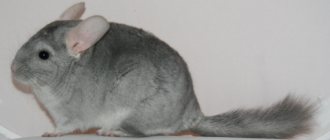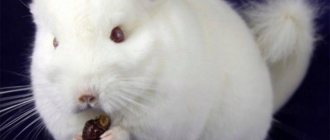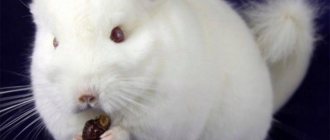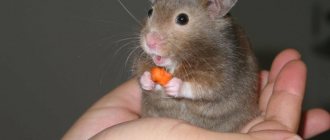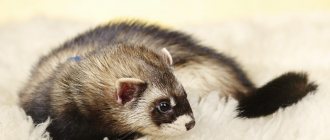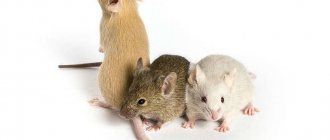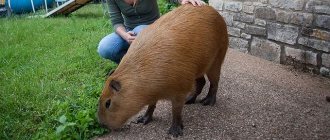Chinchilla breeds
These domesticated rodents are divided into two varieties, which have their own characteristics in the structure of the body and the length of the tail:
- Large short-tailed Peruvian chinchillas came to us from Bolivia and Argentina. These places are their homeland, and there they live in the wild, but only in protected areas, since local residents exterminate them for their valuable fur. In addition to nature reserves, they are also grown on specialized farms. Short-tailed chinchillas not only have dense fluffy fur, but also a fairly strong body. Standing on its hind legs, the animal reaches a height of up to 40 centimeters and weighs about 800 grams. The tail of large rodents is short, covered with stiff, short hair.
- Coast long-tailed chinchillas are common in Chile. They have a small body and a long tail covered with dense fur. Their weight does not exceed 700 grams.
Both chinchilla breeds are light gray in color. However, thanks to the efforts of breeders, long-tailed chinchilla rodents can now boast a huge variety of shades of their magnificent skin.
Angora chinchilla
One of the subspecies of long-tailed animals is the Angora royal chinchilla. It was not bred artificially. The rodent appeared thanks to the efforts of nature itself.
The animal was first noticed in the sixties of the last century. But he was included in the breed directory only in 2001. It is extremely difficult to breed this subspecies in artificial conditions, since the children from the male and female of this breed of chinchillas do not always turn out to have long hair; they often have short hair. It is for this reason that breeding Angora dogs requires the breeder not only to be professional, but also to carefully select pairs.
Angoras have silky long fur and a luxurious tail. In addition, they have long hair on their heads and paws. This breed of chinchilla has a flattened muzzle, which is why people call them Persian. The animals themselves are black, blue, diamond and purple.
Dwarf chinchilla
Mini chinchillas are also a natural genetic mutation. These animals have a small body, short legs and a bushy tail. The weight of rodents does not exceed 300 grams.
Dwarf domestic chinchillas give birth to the same cubs as their ordinary counterparts, so childbirth is difficult to endure. In most cases, babies do not survive. The animal must be under the supervision of a veterinarian throughout pregnancy. The shades of these cute animals can be different.
Chinchilla big
The large or short-tailed chinchilla is also called the royal or Peruvian chinchilla. The animal is originally from South America, but is no longer found in natural conditions. The short-tailed chinchilla is quite large in size - its body length reaches 40 cm, and its weight can reach up to 900 grams. The rodent is not so popular for keeping at home, but its thick and dense fur has made this animal a valuable game animal - they are bred on special farms. A large chinchilla has only a natural color - gray of all shades.
Causes of unpleasant odor
A foul odor can appear for two reasons:
- improper care of your pet;
- problems with his health.
In order for the animal to please others and not cause them discomfort, you need to understand in detail possible mistakes in order to avoid unpleasant consequences.
Important! A chinchilla should absolutely not be allowed to roam around the apartment unattended. The animal is very inquisitive and gnaws on everything that gets in its way, so a walk can end in poisoning, electric shock, suffocation, etc.
P.
Conditions of detention
There are a number of reasons that can lead to various diseases in an animal. The cheerfulness of a pet depends on how well the conditions for its life in your apartment are created.
The main factors influencing the health and mood of a chinchilla are:
Room air temperature. The most suitable temperature is +18…+20°C. Temperatures below or above normal negatively affect the health and activity of the chinchilla. Fluffy becomes lethargic and drowsy and refuses to eat. The temperature of +26°C is critical for the animal, causing heatstroke with a fatal outcome. Drafts. In the room with the cage there should always be a flow of fresh air, but without drafts that can cause colds in the animal. Air humidity. It is required to create humidity in the range of 50–60%. Chinchillas do not feel comfortable in rooms with high humidity. Direct sunlight. Placing the cage on the sunny side can lead to various diseases. Loud and sharp sounds. Chinchillas are very shy, so you should avoid shouting, loud music, etc.
etc., careless behavior can lead to stress and illness in the animal. Correctly selected cell. The size of the display case must be at least 70 cm high and 50 cm wide
The cage should be equipped with a drinking bowl, feeding trough, hay box and litter tray, as well as a lot of various shelves for entertainment. And if you also install a running wheel and a hammock, then your chinchilla will be infinitely happy. Nutrition. In addition to food and hay, which form the basis of the diet, rodents should receive plenty of twigs and salt wheels for grinding down their teeth. Chinchillas also love other healthy treats: dried apples, rose hips, hawthorn. Toilet filler. You can use sawdust, wood pellets, or buy regular cat litter. Many people mistakenly believe that hay is a suitable material for a tray. Hay is good for nutrition, but once it is collected in the cage as bedding, it must be removed before it becomes moldy or begins to rot.
Did you know? The chinchilla's skeleton has the ability to compress vertically, so they can penetrate the narrowest cracks and holes.
Animal diseases and health problems
Insufficient care is not the only reason for the foul odor emitted by the pet. Sometimes, despite the ideal cleanliness of the cage and tray, an unpleasant odor appears. It’s worth sounding the alarm if the animal itself smells. Very often, the cause of this kind of trouble can be health problems with the chinchilla.
If the animal smells bad, these could be the following possible ailments:
- Chronic diarrhea.
- Intestinal infection.
- Diseases of the urinary system.
- Complications after childbirth.
- Dental diseases.
The appearance of an unpleasant odor may be a consequence of the animal’s negative emotional state. A chinchilla can become stressed for several reasons. These include:
- severe fear;
- fight among teenage rodents;
- female refusal;
- prohibition of free movement outside the cage.
Risk factors
It is easier to protect your pet from injury and illness than to treat it. It is advisable for the owner to familiarize himself in advance with factors that can worsen the quality of life of a chinchilla and affect its duration.
Obesity
The domestic chinchilla moves less than its body requires, which affects the digestive system. For her, you should purchase special granulated food, hay and treats.
Chinchillas tolerate hunger much better than overeating. In a rodent restricted in movement, an excess of high-calorie food causes obesity.
The animal will not refuse the offered nuts, fried food from the human table, or its favorite delicacy, even if it is full. The owner must control the amount and composition of the diet personally, without relying on the pet’s instincts.
In captivity, chinchillas can only live in a cage or special pen. Even a spacious showcase does not provide enough space to realize the accumulated energy. Therefore, regular walks are very important for the health of the rodent. The chinchilla's home should be equipped with a wheel and special toys that promote motor activity.
The food must be fresh and free of mold
Digestive system disorders
Diseases of the gastrointestinal tract can occur when animals consume low-quality or unsuitable food. The problem can be recognized by the characteristics of the feces, the behavior of the chinchilla and by palpating the abdomen.
To avoid eating disorders, you need to make sure that your pet’s food is of high quality, without signs of rotting or mold.
There should be no harmful food within the chinchilla's reach. New foods should be introduced into the diet gradually, allowing the body to adapt to them.
Injuries
Outside the cage, the pet can only be under the supervision of the owner. In the apartment environment there are many things that are dangerous for the animal. He should not be allowed to chew on synthetic and toxic materials. Contact with sharp and hot objects should be prevented. Injuries due to pets playing with electrical wires are common.
Smooth cage surfaces cause foot damage. Corns, ulcers and peeling appear on the hind legs. The floor of the chinchilla's home should be covered with hardwood sawdust; you can place a piece of trunk in the cage.
Poisoning
Poisoning can be divided into two groups: acute and chronic. Symptoms of the first appear within a few hours of consuming the substance: vomiting, mucus discharge from the mouth and nose, weakness, possible bloating and loose stools.
Chronic is the systematic entry of toxins into the animal’s body. Toxic substances have a detrimental effect on the condition of organs, but outward symptoms may not appear.
Chinchillas with dark fur
These rodents include black velvet chinchillas with rich black fur and a white belly.
Black velvet
This color combines black and white. The animals have a black body and tail, and a white belly. This contrast looks very impressive and the clearer the color boundaries, the higher the price of a chinchilla and the more valued the breed is.
This species of rodent was bred in the 60s of the last century. Breeders believe that the dark skin is evidence of the high quality of the breed. Chinchillas may have light stripes on their limbs, a charcoal mask, and dark fur on their heads.
The older a rodent gets, the more pronounced its breed characteristics become. Since the black fur gene is lethal, crossing with representatives of your own breed is unacceptable; black chinchillas can only be mated with rodents of other colors.
Rodents with gray color
Gray standard
Gray chinchillas are found both in the wild and in captivity.
Breeders divide them according to the color itself and its depth. Gray chinchillas are:
- light gray;
- medium gray;
- dark;
- moderately dark;
- extra dark.
Gray coloring is standard for chinchillas living in the wild and in domestic environments. The back of rodents is dark, the sides are light, and the belly is white. The wool has two shades. It is gray-blue at the base and black at the ends of the hairs.
Individuals of gray shades, unlike other rodents, are distinguished by very good health. In addition, the age of chinchillas of this shade to bear their first offspring is much lower than that of other subspecies. They can be crossed with absolutely any variety. Rodents have fur that is delicate and soft to the touch.
Light gray
Light gray fur with a silver tint looks very impressive. These chinchillas have a light chest, belly and limbs.
Medium gray
The most common color. The body of the animals has a uniform gray tint, the fur on the stomach, limbs and chest is light.
Dark
The fur has a gray tint with a bluish tint. The belly and chest of rodents are light, standing out well against the background of the rest of the fur.
Moderately dark
The fur of rodents has a dark gray tint, turning into ashy on the face, limbs and sides. Chinchillas have a bluish-white belly.
Extra dark
Many breeders prefer charcoal gray chinchillas with light sides and chest. The belly of this subspecies of rodents is almost white.
Description of the animal
We should start with the fact that these animals belong to the category of rodents. The body is quite large - depending on the sex and breed, its length can range from 22 to 38 centimeters. In this case, the length of the tail reaches 15-17 centimeters. On a large, slightly elongated head with curious eyes there are rounded ears. Long vibrissae grow around the nose - sometimes they grow up to 10 centimeters. The front paws are five-toed, and the hind paws are four-toed. But the latter are twice as long, which allows chinchillas to make serious high jumps. Thin, flexible fingers allow you to grab food and also help you climb vertical surfaces.
The ears have special membranes that cover the ears and prevent foreign objects from entering during sand baths. Males are slightly smaller than females. On average, their weight is 700 grams, while that of females is 800 grams.
They are most active at night, when they go hunting. Large eyes, sensitive ears and long whiskers give them the ability to perfectly navigate in the dark.
In general, the animals are very beautiful, even elegant. It is no coincidence that even a breed of silver chinchilla cats has appeared, the owners of which have only positive reviews.
Dwarf chinchillas
The dwarf chinchilla is not a separate breed. This is a genetic mutation, fixed or manifested by chance. The size of the dwarf animal is much smaller than its ordinary counterparts and its weight can reach only 300 grams. Breeding these ornamental rodents is a difficult matter. Females often experience difficulty during childbirth, and the offspring have few viable young. Small chinchillas can be found in a wide variety of colors and color morphs.
White Wilson
Story
It is believed that the name of this chinchilla breed was given in honor of Mrs. Wilson. According to some reports, it was on her ranch that these furry animals appeared. At first, the breeder thought the animal was an albino because of its white color. But when the White chinchilla gave birth, it became clear that this was a new type of color.
Color
This breed has different color variations. From snow-white to dark. Which color will depend on the crossing.
It is worth noting that no matter the shade of the coat, the ears and eyes remain unchanged. Other breeds of chinchillas usually have black eyes and ears. White Wilsons, on the other hand, are usually gray or dark gray. The beginning of the tail is surrounded by a dark ring. The belly and limbs are white. The main black of this species is the snow-white tip of the tail.
If there is a yellow color in the fur, this indicates a mixture of the breed and poor quality wool.
In the White Wilson chinchilla, the following types of color are most common:
The mosaic coloration is similar to that of Dalmatians. Her fur is covered with dark spots that have different shapes. This color is considered to be inherited. The value of such fur is determined by the symmetry of the dark spots and their saturation.
Platinum coloring is distinguished by a gray coating over the entire surface of the fur.
The silver color is highlighted by the color of the tips. The tips of this color are gray, which creates the illusion of a silvery coating.
The rarest is the tricolor. With this color, three colors can be seen on the animal’s fur: gray, white and black. Stripes and spots on the fur form a unique pattern. Chinchillas are generally bred for their fur and the profitability of the business. Therefore, this color has one of the highest prices on the market. Increases the cost of both the chinchilla itself and its fur.
Contents of the White Wilsons
This type of pet does not require special care. They only need:
- Spacious and equipped cage (house, running wheel, etc.);
- Bathing;
- Special diet.
Chinchillas prefer to move by jumping. Therefore, the cage must be high enough. It is desirable that it have a variety of shelves, ladders, and tunnels.
Description of the breed
Soviet chinchilla belongs to the large category breeds. Chinchilla rabbits are easily recognized by their large size and beautiful fur.
Breed constitution
Main external signs:
- The body is massive, strong and slightly elongated. Length – 60-70 cm. The sternum is massive, rounded, girth – 38-40 cm. The back is long, with a curve.
- The paws are large, strong, fleshy.
- The head, in comparison with the large body, is small and neat.
- The ears are erect and of medium length.
An adult rabbit weighs from 4 to 8 kg. Average weight – 5-6 kg.
Fur and skin
Chinchilla fur is considered one of the most expensive in the world. The Soviet chinchilla has soft and fluffy fur. Color – silver-bluish. There are separate white patches on the belly and in the eye area, and a black border on the top of the tail and on the ears. In the back of the head there is a light wedge. The eyes are usually cherry-brown, but blue can also be seen.
The fur of this breed is unique; it is not only dense and beautiful, but also has a unique color. Today there are a lot of scammers who pass off the fur of these rabbits as expensive chinchilla fur. And this is no wonder, because both furs are thick, shiny, and their color is almost the same.
Main defects
In a litter there are often rabbits with obvious defects. Such animals are immediately rejected and separated from the herd, since they are not suitable for breeding.
The main defects of the breed include the following:
- drooping croup;
- presence of bald spots;
- uneven fur;
- presence of red color in color;
- back with a hump;
- large ears, drooping and “breaking”.
Character
The character of the Soviet chinchilla is excellent; their behavior is no different from smaller rabbits. They are also kind, sympathetic and love affection. But due to their large size, keeping them at home is too problematic.
Chinchilla as a pet: care and necessary conditions of keeping
These rodents are unpretentious, so keeping them at home is quite easy. However, before buying a pet, you need to know what conditions the rodent will require:
- The pet's cage should be spacious enough and have several tiers. In addition, it must be made of durable material that is safe for the animal;
- The bulk of the diet should consist of grains and hay. It is necessary to select only high-quality grain or granulated feed;
- A couple of times a week, your pet needs sand baths, which help clean the chinchilla’s thick fur.
Chinchilla lifestyle
In their natural habitat, these animals are nocturnal. Therefore, being a pet, the chinchilla prefers to sleep during the day, being active only at night. Some owners try to force the animal to stay awake during the day and sleep at night, but this is quite harmful to the pet’s health. Such innovations can lead to the chinchilla becoming nervous and irritable, and this always entails stress and even psychological disorders.
Features of character and behavior
The character of this animal, just like the human one, can be divided into 4 types:
- Choleric;
- Sanguine;
- Melancholic;
- Phlegmatic person.
Choleric
Choleric is very timid. If you are careless and scare such a pet, he will begin to rush around the cage in panic, which can harm his physical and mental health. Otherwise, these are nimble and active rodents. They are sensitive sleepers, so they wake up at the slightest rustle.
Sanguine people are easy to tame
Sanguine
It is the sanguine animals that are easiest to accustom to hands, since rodents of this type are very trusting. Like choleric people, these animals are active and inquisitive, but not so timid, therefore they react more calmly to various noises. These chinchillas do not like to sit in one place for a long time and with great pleasure walk around the apartment and communicate with the owner.
Melancholic
Animals of this type are considered the calmest and quietest. At the same time, melancholic people are incredibly timid, and can hide for a long time in the farthest corner of the cage upon hearing a loud sound. It is not advisable to let such pets out for walks around the house, since the animal will simply hide in a secluded corner, from where it will be very difficult to get it.
Phlegmatic person
This is the most calm and balanced look. He prefers long sleep to active games, and can spend the whole day in his house. Even during waking hours, phlegmatic rodents move rather slowly, freezing in one place for a long time, looking at everything around them.
Features of collective and solitary keeping of animals
If you decide to have one animal, then you don’t have to worry that it will be bored without neighbors. Chinchillas can live their entire lives completely alone. Those who still decide to have several pets should remember the following features of chinchillas:
- If you are going to breed rodents, buy an already formed pair;
- It is allowed to keep a female with several males in one cage;
- If you are not interested in offspring, it is better to get two males, so they can get along, unlike several females.
Reproduction
Chinchillas are ready to breed when they are 8 months old. After fertilization, the female bears offspring for 100-110 days. If you want to keep your pet healthy, do not expect more than two pregnancies per year.
In one litter, from 2 to 4 cubs are born. Feeding of the offspring occurs with the help of mother's breast milk. If it is not enough, newborns must be switched to additional formula. When the offspring grows up and reaches the age of two months, they begin to be accustomed to an adult diet.
How long does a chinchilla live at home?
Chinchillas are the longest-living rodents. Theoretically, the animal is capable of reaching the age of thirty years. In fact, in the wild, only rare individuals manage to overcome the twelfth year. How long chinchillas live at home depends on care. Statistics range from 8 to 25. On average, pets live up to 15–20 years.
How long a chinchilla lives depends primarily on its sensitivity and speed. By the age of 12, a rodent’s mobility decreases and it becomes more difficult for it to avoid predators, so only rare individuals can overcome this milestone.
Chinchillas live in a rocky region where food is scarce and there are few sources of water and shelter. Animals of both sexes live in the same colony and nothing prevents reproduction. A female chinchilla can reproduce 2-3 times a year, but the body is exhausted from such a rhythm, which affects the health of the individual.
Genetic calculator
Chinchilla genetics is an interesting and rather complex science. A large combination of genes and their combinations, dominant and recessive manifestations can confuse even experienced breeders. Therefore, a special genetic calculator for chinchilla colors was developed. The main genes of the parents are entered into the calculator: white, beige, sapphire, ebony, purple, velvet and angora, as well as the degree of manifestation of the genes:
- Present or not,
- Double or not
- Carrier or not,
- Gene shade (from light to dark).
Based on the data obtained, the calculator calculates not only the genotype of the parent pair, but also all possible colors of the offspring and the probability of obtaining them. The calculator is useful not only for beginning breeders, but also for those who want to breed a new color morph or fix a specific gene. You can find a genetic calculator on numerous websites of chinchilla breeders and large nurseries.
Animals with beige fur
The main shade of these rodents is pastel. However, it has several variations. Additionally, the older the chinchilla, the darker its fur will be. It can be brown, red or beige. This type of rodent can be crossed.
Homobeige
This species of rodent has light beige fur with uniform coloring and pink ears. For this shade, single dark hairs are acceptable.
Heterobeige
In these rodents, on the contrary, the color is uneven. The entire coat is beige, and the undercoat and ends of the hairs are brown. When choosing a chinchilla, you should pay attention to the color distinction between the rest of the body and the belly.
Beige tower
The color of the fur of these animals varies from light to dark beige, which is combined with a brown pattern located along the spine.
How to determine the age and gender of a chinchilla?
It is difficult for an ordinary person to accurately determine the age of an adult, but the difference between a baby and an adult chinchilla is obvious.
The puppy has a rounded muzzle and small round ears. The neck is short. If an individual has white teeth, then it is milk-fed and is no more than two months old. Over time, the rodent's teeth acquire a dark shade and turn orange.
When the animal is 7 months old, its genitals are fully formed, which allows us to approximately understand the age of the animal.
It is more difficult to distinguish a two-year-old from a five-year-old. First of all, you should weigh the animal: the weight of an adult chinchilla varies between 500-900 grams. The older the pet, the more weight it will have (if proper care is provided). The skin on the paws can also indicate the age of the animal. Young individuals have smooth skin. In older representatives it is rough. A chinchilla of venerable age cannot boast of activity like its younger counterparts.
How to extend the life of a chinchilla
How many years chinchillas live at home depends on their genetic data. It happens that an unscrupulous breeder sells litter from a union of close relatives, or from animals susceptible to diseases.
Genetic disorders may not appear externally. To insure against unpleasant discoveries, you should only purchase a rodent from nurseries with a good reputation.
The life expectancy of a chinchilla raised in an apartment can reach its maximum if the animal is born healthy and surrounded by competent care of the owner.
- place the animal in a spacious cage at least a meter wide, covered with sawdust;
- Clean your home at least once a week;
- organize regular walks around the apartment under the supervision of the owner;
- ensure that the diet is balanced;
- maintain a suitable temperature;
- monitor the physical condition of the pet.
Chinchillas need to be examined regularly
Chinchilla examination
Some violations do not cause discomfort to the chinchilla and do not affect its behavior. Therefore, the owner should regularly examine the pet in order to recognize the problem in time and prevent advanced stages.
Signs of chinchilla health:
- clean ears and eyes without discharge;
- dry nose without scabs and mucus;
- coat without bald spots, the pile is dry, not sticky, shiny, even;
- the teeth are orange in color, the lower incisors are shorter than the upper ones and are located behind them;
- the mouth is mostly closed, there is no active salivation;
- boluses are shaped like rice, moist, do not stick to the fur;
- there is no mucus, blood clots, or loose stools in the discharge;
- genitals are clean, dry and pink;
- The weight of an adult chinchilla is within the normal range, there are no sharp jumps in loss or gain;
- behavior is consistently active, the chinchilla does not show anxiety, apathy or aggression;
- breathing is measured and even.
Changes in your pet's appearance, weight, and behavior can be signs of serious illness. If the cause is unknown, a visit to the veterinarian is required.
Who will you get when crossed?
Of all the above morphs, only three - predominant white, mosaic and silver - have the ability to transmit to the offspring not only their type, but also any variant of white. Therefore, it is not at all necessary that white chinchillas will be born from a chinchilla of the snow-white morph - they can also be mosaic. And the silver individual is capable of giving birth to pure white cubs.
White Wilson is a carrier of both the standard and white genes. Breeders believe that rodents of this species can be crossed with all others without restrictions. But “intratype” crossing (as well as closely related ones) is by no means encouraged: the number of newborn babies may decrease, and their viability will decrease.
Sometimes two white genes in combination do not allow the fetus to develop in the embryonic phase, and such a gene combination is called the “lethal gene.” Well, even a schoolchild knows what lethal is.
Combinations of white Wilson with colors such as black and brown velvet, beige and homobeige give other interesting and unexpected morphs.
An example is crossing a pair of “white Wilson” and “black velvet”. Cubs are capable of producing the following morphs: both types of parents, standard, and white velvet.
Among the descendants of white Wilson, experts call white-pink, or apricot, a particularly beautiful option. This species is of interest to breeders as a carrier of three genes - white, beige and standard. The fur coat of such individuals can be either snow-white or with gray or chocolate-colored spots of various shapes and locations.
It happens that chinchillas of this type, being born beige, after a couple of months are able to change color and appear pure white or golden.
If you are already familiar with this type of pet like a chinchilla, and now you have acquired a Wilson white individual, you will not experience any special conditions for keeping, feeding and caring for them. But if you plan to cross and breed this particular type, this issue should be approached thoroughly, remembering which gene can be crossed with, and with which - in no case.
Interesting video:
White Wilson
Story
It is believed that the name of this place was given in honor of Mrs. Wilson. According to some reports, it was on her ranch that these furry animals appeared. At first, the breeder thought the animal was an albino because of its white color. But when the White chinchilla gave birth, it became clear that this was a new type of color.
Wilson White chinchilla
Color
This breed has different color variations. From snow-white to dark. Which color will depend on the crossing.
It is worth noting that no matter the shade of the coat, the ears and eyes remain unchanged. Other breeds of chinchillas usually have black eyes and ears. White Wilsons, on the other hand, are usually gray or dark gray. The beginning of the tail is surrounded by a dark ring. The belly and limbs are white. The main black of this species is the snow-white tip of the tail.
If there is a yellow color in the fur, this indicates a mixture of the breed and poor quality wool.
The most common color types are:
- Tricolor;
- Platinum;
- Mosaic;
- Silver.
The mosaic coloration is similar to that of Dalmatians. Her fur is covered with dark spots that have different shapes. This color is considered to be inherited. The value of such fur is determined by the symmetry of the dark spots and their saturation.
Platinum coloring is distinguished by a gray coating over the entire surface of the fur.
The silver color is highlighted by the color of the tips. The tips of this color are gray, which creates the illusion of a silvery coating.
The rarest is the tricolor. With this color, three colors can be seen on the animal’s fur: gray, white and black. Stripes and spots on the fur form a unique pattern. Chinchillas are generally bred for their fur and the profitability of the business. Therefore, this color has one of the highest prices on the market. Increases the cost of both the chinchilla itself and its fur.
Contents of the White Wilsons
This type of pet does not require special care. They only need:
- Spacious and equipped cage (house, running wheel, etc.);
- Bathing;
- Special diet.
Chinchillas prefer to move by jumping. Therefore, the cage must be high enough. It is desirable that it have a variety of shelves, ladders, and tunnels.
It is believed that pets develop better if each of them has their own house. This will help avoid quarrels between them and speed up reproduction.
The room where the chinchillas are kept should be between 18 and 20 degrees Celsius. Exposure of your pet to the sun and drafts is fraught. To prevent the animal from suffering from the heat in the summer, you need to install an air conditioner.
To grind a clove, a salt stone must be installed. In addition to grinding, the salt stone contains many microelements and minerals that are useful for the animal.
Chinchillas are considered quite active animals; they often scatter food and sand. The cage must be kept in frequency and disinfected at least 2 times a month.
Nutrition
It is worth feeding herbivore food. It contains useful elements that accelerate growth (flour, oats, wheat, salt, fat, etc.) The addition of green food is not prohibited:
- Oat or wheat sprouts;
- Young nettle greens;
- Horse sorrel;
- Dandelion or plantain.
On average, two to three tablespoons of food per day is enough for one individual.
The most important feature of the diet is hay. Hay helps your pet's digestion. Also helps in grinding teeth, preventing the development of dental hooks on the rear incisors. Just don’t give it in large portions, otherwise the rodent will scatter it around the house.
It is recommended to give: various fruits, nuts, grapes, figs.
This pet should not be overfed; it has a very weak stomach.
Bathing is an integral part of grooming. not in water, but in sand. This means that the cage must have containers with sand, which contains antibacterial additives. This sand feels like fine dust. If it is rough, hard and the touch causes discomfort, then it can harm the pet’s skin.
Advantages and disadvantages
The breed was bred as a universal breed, so it is slightly inferior to the meat subspecies. But with good feeding, you can quickly fatten up heavy rabbits.
Advantages of the Soviet chinchilla:
- They quickly adapt to different weather and living conditions.
- High productivity in females.
- Due to their large size they produce a lot of meat.
- Fur is highly valued due to its high quality and unusual color. The density of the fur is twice as high as that of other breeds.
Flaws:
- Spacious cages are needed for maintenance.
- Requires a lot of grain and hay for feeding.
- The farm requires significant expenses.
Is it possible to be allergic to a pet?
There are many myths circulating that chinchillas do not cause allergies. However, these speculations are completely untrue. Animal fur causes allergic reactions less often than things necessary to care for it
If a person is prone to allergies, then before getting such a pet it is important to visit a chinchilla breeder. It’s worth holding the animal in your hands and observing your reaction.
Sometimes increased sensitivity in the owner occurs even after the chinchilla has lived with him for a long time. Every doctor will advise you to get rid of your pet and all its belongings. But how can you part with your pet so easily? Before taking drastic measures, it is worth trying other options. The first weapon will be an air purifier, with its help it will become easier to breathe. Don’t be lazy once again to carry out wet cleaning in your home and your pet’s.
Simple rules will help you protect yourself from allergies:
- Use a mask when cleaning the cage. This way, dust from the filler and animal fur will not get into the respiratory tract;
- Be sure to wipe the cleaned enclosure with a damp cloth;
- Pressed filler can easily replace ordinary sawdust;
- Swimming is best done in a non-residential area with good ventilation.
Crossing chinchillas
Features of crossing the main breeds
Chinchilla hybridization has its own rules. It is not recommended to crossbreed two black velvet chinchillas as they may not produce offspring.
- If crossed with Wilson white, you will get snow-white velvet. Wilson's beige produces white, silver, mosaic individuals. The Wilson breed also has a lethal gene. Therefore, crossing these two breeds is not recommended. Suitable for crossing beige chinchillas. If they are crossed with individuals of black velvet color, they will get brown velvet, and with Wilson's snow white, they will get a white-pink color.
- To obtain a smoky or chocolate color, they are crossed with a chinchilla - a carrier of the ebony gene. As a result of the hybridization of two homobeige, heterobeige or hetero- and homobeige chinchillas, homobeige animals are obtained. If homobeige animals are crossed with ordinary individuals, then heterobeige animals are born.
- When crossing a brown velvet rodent with an ebony rodent, the color velvet pastel is obtained.
Crossbreeding of non-mainstream breeds
- The fur of the snow-white ebony chinchilla breed is colored white and black. To get such an individual, white heteroebony and homoebony are crossed. Mixing white flowers with rodents is not recommended due to the deadly gene.
- Chinchillas, painted in velvet pastel color, have a bronze back and brick-colored eyes. This color is obtained by hybridizing pastel with brown velvet or velvet ebony. With such selection, the likelihood of obtaining chinchillas with a chocolate-velvet tint of fur increases.
- Homoebony fur is considered interesting - it is very rare to come across a perfectly black color. Hybridization produces homobeige, chocolate brown, and lilac fur.
- Heteroebony breed better than homoebony. The coat color varies from light to dark. This color is obtained after hybridization of homoebony and gray chinchilla.
There are several barriers to breeding
Varieties of colors
Since chinchillas have a lot of enemies in the wild, for their own safety, rodents have a light gray color, inconspicuous among rocky terrain.
Gray is the standard color for these cute animals, but artificially bred chinchilla breeds come in a wide variety of shades. Among them there are black, beige, white and even blue tones of chinchilla fur. Therefore, it is now extremely difficult to imagine that chinchillas originally had only gray colors.
All shades of chinchilla fur can be grouped as follows:
- gray or agouti: two shades that are standard;
- white, having different saturation and an admixture of beige and pinkish;
- brown or pastel, available in a full range of colors up to dark chocolate;
- black with varying degrees of saturation;
- purple, pink and sapphire.
In addition, it should be taken into account that fur colors differ not only in color, but also in:
- recessive. When a chinchilla is only a carrier of the gene responsible for the shade of its coat.
- dominant. When the color is already there and visible from birth.
When breeding rodents, it is extremely important to know what recessive color the male chinchilla and the female selected for mating have.
Results
Breeding chinchillas is a very profitable business. However, in order to become an experienced breeder, you should take into account not only the breeds of chinchillas and their colors, but also know all the intricacies of the care and nutrition of these magnificent animals.
Gray and beige rodents are easier to breed, they are more common, and their babies are cheaper than, for example, sapphire and purple ones. Crossing and breeding chinchillas is an extremely complex process, so it needs to be approached wisely and only done by those people who are truly interested in it. You should not do this for the sake of banal profit, since nothing good will come from such a business.
Not only breeders, but also scientists around the world are engaged in breeding new breeds. They are driven to this by the popularity of rodents not only as pets, but also by their breeding as specimens to obtain valuable fur.
Keeping a chinchilla at home is not very easy, but it is worth it. The animals love their owners very much and treat them with tenderness and love. Breeders advise purchasing chinchillas in pairs, because there is nothing more pleasant than watching their games, affection, love and friendship, which a person can only envy.
Chinchilla breeds: Shades and breeds of animals with photographs and names
Many believe that chinchilla breeds are fiction, and that the animals can be exclusively gray, the way they are most often seen in pet store windows and in photos on the Internet. However, this opinion is wrong. Breeders have been working for decades to ensure that the breeds and shades of these funny rodents only increase.
Below we will introduce you to the varieties of chinchilla colors and their breeds offered in nurseries.

